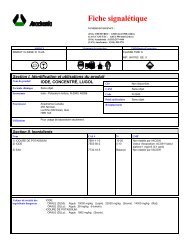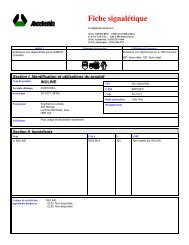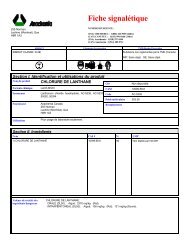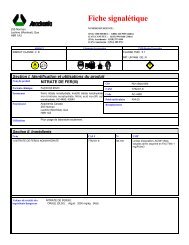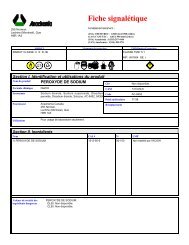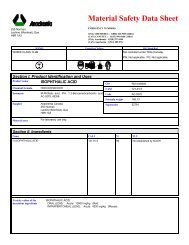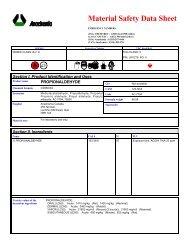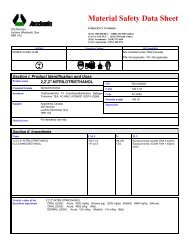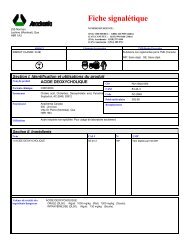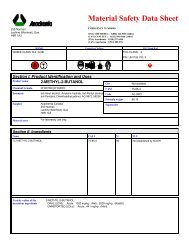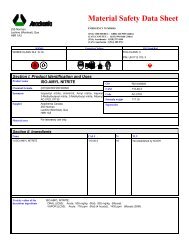2822 SODIUM DICHROMATE (English) ANACHEMIA MSDS ...
2822 SODIUM DICHROMATE (English) ANACHEMIA MSDS ...
2822 SODIUM DICHROMATE (English) ANACHEMIA MSDS ...
You also want an ePaper? Increase the reach of your titles
YUMPU automatically turns print PDFs into web optimized ePapers that Google loves.
Section III. Physical Data<br />
Physical state and<br />
appearance / Odor<br />
pH (1% soln/water)<br />
Odor threshold<br />
Percent volatile<br />
Freezing point<br />
Boiling point<br />
Specific gravity<br />
Vapor density<br />
Vapor pressure<br />
Water/oil dist. coeff.<br />
Evaporation rate<br />
Solubility<br />
Solid. (Reddish to orange crystals. Odorless.)<br />
3.5 (10% aqueous solution)<br />
Not available.<br />
0% at 21°C<br />
Dehydrates at 100°C.<br />
Decomposes at 400°C.<br />
2.52 (Water = 1)<br />
Not applicable.<br />
Not applicable.<br />
Not available.<br />
Not applicable.<br />
74% (in H2O) at 20°C.<br />
Section IV. Fire and Explosion Data<br />
Flash point<br />
Flammable limits<br />
Auto-ignition temperature<br />
Fire degradation<br />
products<br />
Fire extinguishing<br />
procedures<br />
Fire and Explosion<br />
Hazards<br />
None<br />
Not available.<br />
Not available.<br />
Section V. Toxicological Properties<br />
<strong>SODIUM</strong> <strong>DICHROMATE</strong> page 2/4<br />
Use flooding quantities of water. Wear adequate personal protection to prevent contact with material or its combustion products.<br />
Self contained breathing apparatus with a full facepiece operated in a pressure demand or other positive pressure mode. Cool<br />
containing vessels with flooding quantities of water until well after fire is out. Move containing vessels from fire if without risk.<br />
Powerful oxidizing agent; may ignite oxidizable materials. Contributes to combustion of other materials. Contact with<br />
other material may cause fire and/or explosion. Contact with other material may form shock, heat or friction sensitive<br />
mixtures. Container explosion may occur under fire conditions or when heated. Emits toxic fumes under fire conditions.<br />
Routes of entry Inhalation and ingestion. Eye contact. Skin contact. Skin absorption.<br />
Effects of Acute<br />
Exposure<br />
Skin<br />
Inhalation<br />
Ingestion<br />
Chromium and sodium oxides.<br />
May be fatal by ingestion, inhalation or skin absorption. Severe irritant! Potentially harmful amounts can cause damage to<br />
kidneys, liver, blood, lungs, eyes, skin, respiratory system, and/or bone marrow.<br />
Eye Causes conjunctivitis, severe irritation or burns and loss of vision. May cause permanent damage.<br />
Causes severe irritation. Prolonged exposure may result in skin burns and ulcerations. Contact with broken skin may lead to<br />
formation of firmly marginated "chrome sores". Massive overexposure could lead to damage to the kidneys, liver, blood, and/or<br />
bone marrow, kidney failure and death. A strong sensitizer which may cause skin rash.<br />
Inhalation of dust or mist may irritate the nasal septum and respiratory tract. Destructive to tissues of mucous<br />
membranes. Prolonged or repeated exposure may cause ulceration and perforation of the nasal septum. May cause<br />
headache, nausea, vomiting, chemical pneumonitis and pulmonary edema. May cause sensitization by inhalation. Can<br />
cause liver, kidney, and lung damage.<br />
Burns in mouth, pharynx and gastrointestinal tract (can cause severe tissue destruction.). May cause vomiting, nausea,<br />
abdominal pain, fever, diarrhea, coma, bleeding and/or tissue ulceration, gastroentritis, toxic nephritis with glycosuria,<br />
blood and bone marrow damage, liver and kidney failure, peripheral vascular collapse and death. Estimated lethal dose is<br />
5 g.



